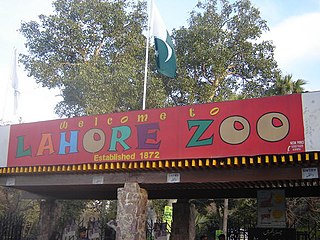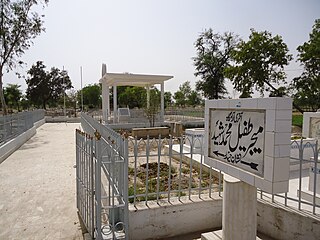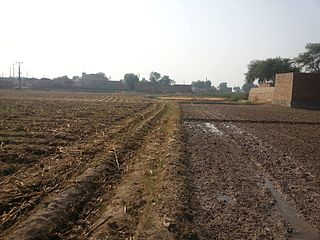
Lahore Zoo in Lahore, Punjab, Pakistan, established in 1872, one of the largest zoos in Pakistan. It is currently managed by the Forest, Wildlife and Fisheries department of the Government of Pakistan. Today the zoo houses a collection of about 1378 animals of 135 species. Lahore Zoo was the host of the fifth annual conference of SAZARC in 2004.

Vehari also spelled Vihari, is a city and the headquarters of Vehari District in the Punjab province of Pakistan. It is Pakistan's 62nd largest city. Vehari is about 100 km (62 mi) from the historical city of Multan. Vehari is located at the Multan-Delhi Road constructed by Emperor Sher Shah Suri. It is at an altitude of 135 m (443 ft).,{chak No 65.kb}

Vehari District is a district in the Punjab province of Pakistan. The city of Vehari is the capital of district while Burewala is the largest city of the district.

Lodhran District, is a district in the province of Punjab, Pakistan, with the city of Lodhran as its capital. Located on the northern side of the River Sutlej, it is bounded to the north by the districts of Multan, Khanewal and Vehari, to the south by Bahawalpur, to the east lie the districts of Vehari and Bahawalpur; while district Multan lies on the western side.

Tehmina Daultana is a Pakistani politician who had been a member of the National Assembly of Pakistan.

Mailsi is a city in southern Punjab, Pakistan. It is the headquarters of Mailsi Tehsil, an administrative subdivision of Vehari District.

Mailsi, is a subdivision tehsil, of Vehari District, in the Punjab province of Pakistan. It is administratively subdivided into 31 Union Councils, two of which form the tehsil capital Mailsi.

Vehari Tehsil, is an administrative subdivision (tehsil), of Vehari District in the Punjab province of Pakistan. The city of Vehari is the headquarters of the tehsil which is administratively subdivided into 26 Union Councils.

The wildlife of Pakistan comprises a diverse flora and fauna in a wide range of habitats from sea level to high elevation areas in the mountains, including 195 mammal, 668 bird species and more than 5000 species of Invertebrates. This diverse composition of the country's fauna is associated with its location in the transitional zone between two major zoogeographical regions, the Palearctic, and the Oriental. The northern regions of Pakistan, which include Khyber Pakhtunkhwa and Gilgit Baltistan include portions of two biodiversity hotspot, Mountains of Central Asia and Himalayas.

Bahawalnagar Tehsil is a tehsil located in Bahawalnagar District, Punjab, Pakistan. There are two towns in Bahawalnagar Tehsil: Bahawalnagar and Dunga Bunga. The city of Bahawalnagar is the headquarters of the tehsil which is administratively subdivided into 31 Union Councils.

Lal Suhanra is a national park in Pakistan that is situated in the Bahawalpur district of Punjab province. It is one of South Asia's largest nationals parks, and is a UNESCO declared Biosphere Reserve. Lal Sohanra is notable for the diversity of its landscape, which includes desert, forest and wetland ecosystems.
Lahore Zoo Safari Park is a zoo in Lahore, Pakistan.
Bahawalpur Zoo, established in 1942, is a 25-acre (10 ha) zoological garden in Bahawalpur, Punjab, Pakistan. It is managed by the Government of Pakistan.

Jallo Park, established in 1978, is a public recreation and wildlife site located in Lahore District, Punjab, Pakistan. Spread over an area of 461 acres (187 ha), it is one of the three main wildlife parks located in Lahore, the other two being Changa Manga and Lahore Zoo Safari. The park is 7 kilometres (4.3 mi) east to Lahore city. Facilities at Jallo Park include a Forest Research Centre, Wildlife Breeding Center, restaurants, coffee shops, a theme park, a sports complex, swimming pool, and a large lake for fishing and boating. It is currently funded by Punjab Wildlife and Parks Department of Government of Punjab. It is easily accessible by taxi, TransLahore buses and Lahore City Commuter trains that stop at Jallo Railway Station. Now the area of 100 acre is allotted to the Parks and Horticulture Authority Lahore by govt of Punjab there PHA established Botanical Garden Jallo and Butterfly House facility for the public.
Biosphere reserves are established according to the UNESCO's Man and the Biosphere Programme (MAB) to promote sustainable development for conservation of biological and cultural diversity. As of 2016, the Lal Suhanra Biosphere Reserve and Ziarat Juniper Forest are the only two biosphere reserve in Pakistan, which were approved by UNESCO in 1977 and 2013 respectively. A number of initiatives and projects have been undertaken to promote and develop other biosphere reserves in Pakistan but due to weak implementation this has not yet been materialized. In July 2012, Pakistan Museum of Natural History and Beijing Museum of Natural History signed a MoU to work on trans-boundary biodiversity and to improve MAB related activities in the Karakoram, Himalaya, and Hindukush regions.
Bir Shikargah Wildlife Sanctuary is situated in Panchkula district of Haryana state, India. It is spread over an area of 767.30 hectares. It also houses Vulture Conservation and Breeding Centre, Pinjore.
Khol Hi-Raitan Wildlife Sanctuary is situated in Panchkula district of Haryana State, India. It is 0.5 kilometres (0.31 mi) away from Panchkula on the Morni Road and its aerial distance from the Bir Shikargah Wildlife Sanctuary is only 3 kilometres (1.9 mi).
Saeed Ahmed Khan Manais is a Pakistani politician who was a member of the National Assembly of Pakistan, from June 2013 to May 2018 and was a member of the Provincial Assembly of the Punjab between 1985 and 1999.
Vehari is a city in Punjab, Pakistan.
The Himalayan Wildlife Foundation (HWF), previously called the Himalayan Wildlife Project, is a nonprofit, non-governmental organization based in Islamabad Pakistan focused on conservation of biodiversity and cultural heritage in Pakistan. The Himalayan Wildlife Foundation is widely attributed to have saved the Himalayan Brown Bear from extinction in Pakistan, although it is not yet clear whether enough genetic diversity is available within the current population to sustain the population. The HWF is also involved in other major conservation efforts such as Rohtas Fort Conservation Programme at Rohtas Fort, and community-based management interventions in Gumot National Park, Musk Deer National Park and Neelum Valley in Azad Jammu and Kashmir. Efforts of the Himalayan Wildlife Foundation in Pakistan are considered some of the leading efforts in conservation and socioeconomic development in the Himalaya.












